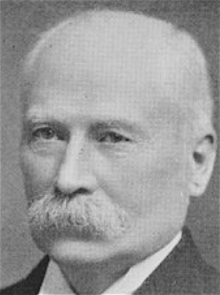
Robert Rowand Anderson [also known as Sir Robert Rowand Anderson] was born in Liberton, near Edinburgh, Scotland on 5 April 1834. After studying at Edinburgh University, he was articled to John Lessels (1808-1883) in Edinburgh from 1852 to 1857. He then worked as an assistant to George Gilbert Scott (1811-1878) in London from 1857 to 1859 and to Petrus Josephus Hubertus Cuijpers (1827-1921) in Roermond, Netherlands in 1859-60), following which he returned to Scott's office to work on the supervision of the building of St James the Less at Leith.
Anderson was briefly in partnership David Bryce (1803-1876) and his nephew, John Bryce, junior (c.1842-1922) as Bryce, Anderson & Bryce in Edinburgh in 1873. After working alone for a period he formed a partnership with George Washington Browne (1853-1939) as Anderson & Browne in Edinburgh in 1881. In 1883 the practice merged with that of Hew Maitland Wardrop (1856-1887) to form Wardrop, Anderson & Browne. When, in 1885, Browne withdrew from the practice, the title of the firm changed to Wardrop & Anderson. Wardrop died in 1887, however, Anderson retained the name of the firm until 1899 when he formed a new partnership with Frank Lewis Worthington Simon (1862-1933) and Alexander Hunter Crawford (1865-1945) as Anderson, Simon & Crawford. The partnership was dissolved in 1902 and the following year Anderson formed his last partnership, Rowand, Anderson & Paul with Arthur Forman Balfour Paul (1903-1934). In 1919 Anderson retired and Paul became the sole partner in the practice.
In 1893 Anderson established the School of Applied Art in Edinburgh to train architects and craftsmen and in 1895 he was responsible for instigating the National Art Survey to record all pre-eighteenth-century buildings in Scotland, which has been credited with inspiring the revival of the Scottish Renaissance style.
He was elected a Fellow of the Royal Institute of British Architects (FRIBA) in 1874 and was awarded the RIBA Royal Gold Medal in 1916. In 1896 he was elected an honorary Academician of the Royal Scottish Academy. He was knighted for his services to architecture in 1902. He died at his home, Allermuir House, Colinton, Edinburgh on 1 June 1921.
Principal works by Anderson included All Saints Church, Edinburgh (1866-78); Catholic Apostolic Church, Edinburgh (1873-94); Medical School and McEwan Hall, Edinburgh University (1875-97); Mount Stuart, Isle of Bute, Scotland (1877); Conservative Club, Princes Street, Edinburgh (1882); Central Station Hotel, Glasgow (1884); National Portrait Gallery, Edinburgh (1884); National Portrait Gallery (1885-90);the completion with dome of Old College, Edinburgh University (1886); Free Church, Morningside, Edinburgh (1891-92); McEwan Hall, Teviot Place, Edinburgh (1897); Pollockshaws Burgh Buildings, 2025 Pollockshaws Road, Glasgow (1897); and Pearce Institute, 840 Govan Road, Govan, Glasgow (1903)
_____
See also:
Dictionary of Scottish Architects 1660-1980
Historic Environment Scotland - contains 142 records on architectural work by Robert Rowand Anderson
Armstrong, Barrie and Armstrong, Wendy. The Arts and Crafts movement in the North East of England. A handbook. Wetherby, England: Oblong, 2013
Cumming, Elizabeth. Hand, heart and soul: the Arts and Crafts movement in Scotland. Edinburgh: Berlinn Limited, 2006
Directory of British Architects 1834-1914. Compiled by Antonia Brodie, et al. Volume 1: A-K. London; New York: British Architectural Library, Royal Institute of British Architects/Continuum, 2001
Gow, Ian. ‘Sir Rowand Anderson's National Art Survey of Scotland’. Architectural History vol. 27, 1984 pp.543-554
Hall, Michael. 'Mount Stuart, Isle of Bute; Architect (1879): Sir Robert Rowand Anderson'. Country Life vol. 189, no. 24, 15 June 1995 pp. 56-63.
Hamilton, Alec. Arts & Crafs Churches. London: Lund Humphries, 2020
Hannah, Rosemary. 'St Sophia's Church, Galston: 'the vast space of the interior'. Architectural History vol. 46, 2003 pp. 255-268 [St Sophia's Church, Galston designed by Robert Rowand Anderson, 1885-86]
McKinstry, Sam W. The life and work of Sir Robert Rowand Anderson 1834-1921. Ph.D. thesis, University of St. Andrews, 1987
McKinstry, Sam W. 'Rowand Anderson and 'Greek' Thomson: Scottishness and the Glasgow/Edinburgh divide'. Architectural Heritage no. 9, 1998 pp. 31-43
McKinstry, Sam. Rowand Anderson: the premier architect of Scotland. Edinburgh: Edinburgh University Press, 1991
Murdoch, William Garden Blaikie. 'A Scottish revival of Mediaevalism'. Quarterly of the Royal Incorporated Architects of Scotland vol. 35, 1931 pp. 69-78 [Residence built for himself at Allemuir, Collinton, Edinburgh]
‘Obituary’. The Builder vol. 120, 10 June 1921 pp. 734, 739
‘Obituary’. Royal Institute of British Architects Journal vol. 28, 1920-21 pp. 457-458, 471, 511
Paterson, A. N. ‘Sir Robert Rowand Anderson: An Appreciation’. Royal Institute of British Architects Journal, new series vol. 3, no.28, 1921 pp.511-513
Service, Alastair. Edwardian Architecture. A Handbook to Building Design in Britain 1890-1914. London: Thames & Hudson, 1977